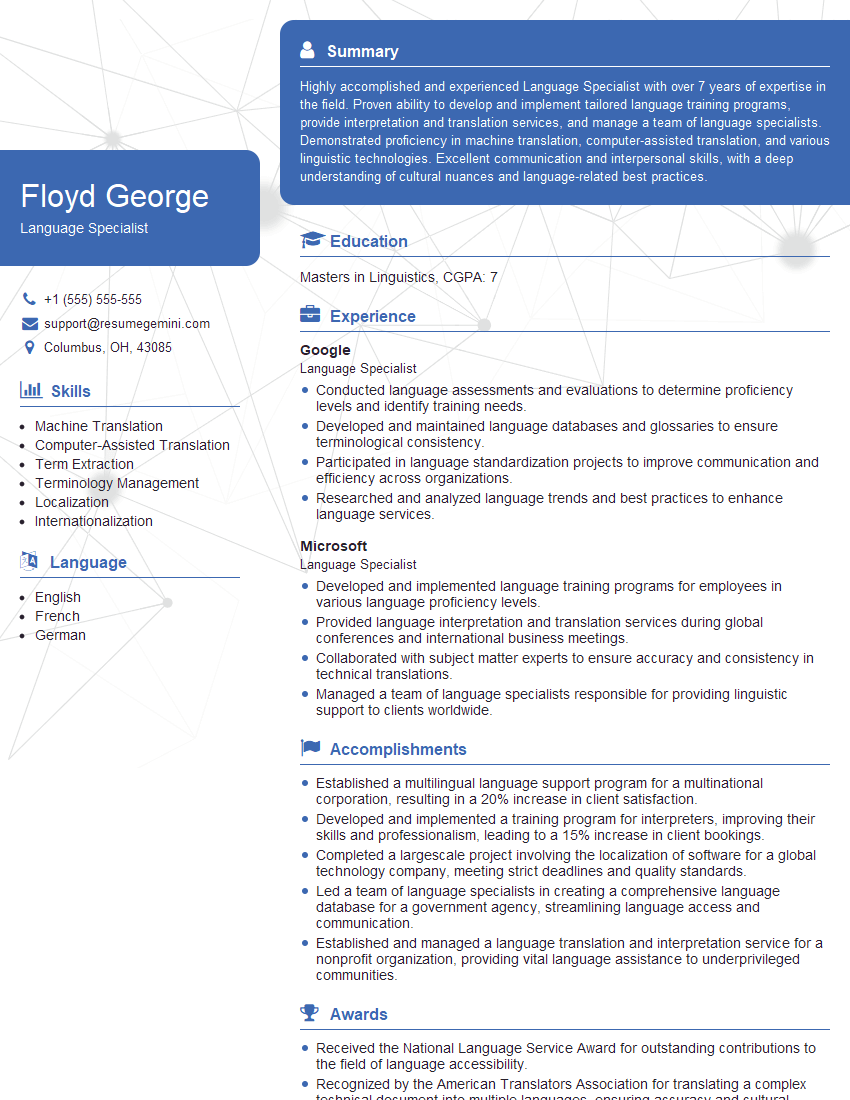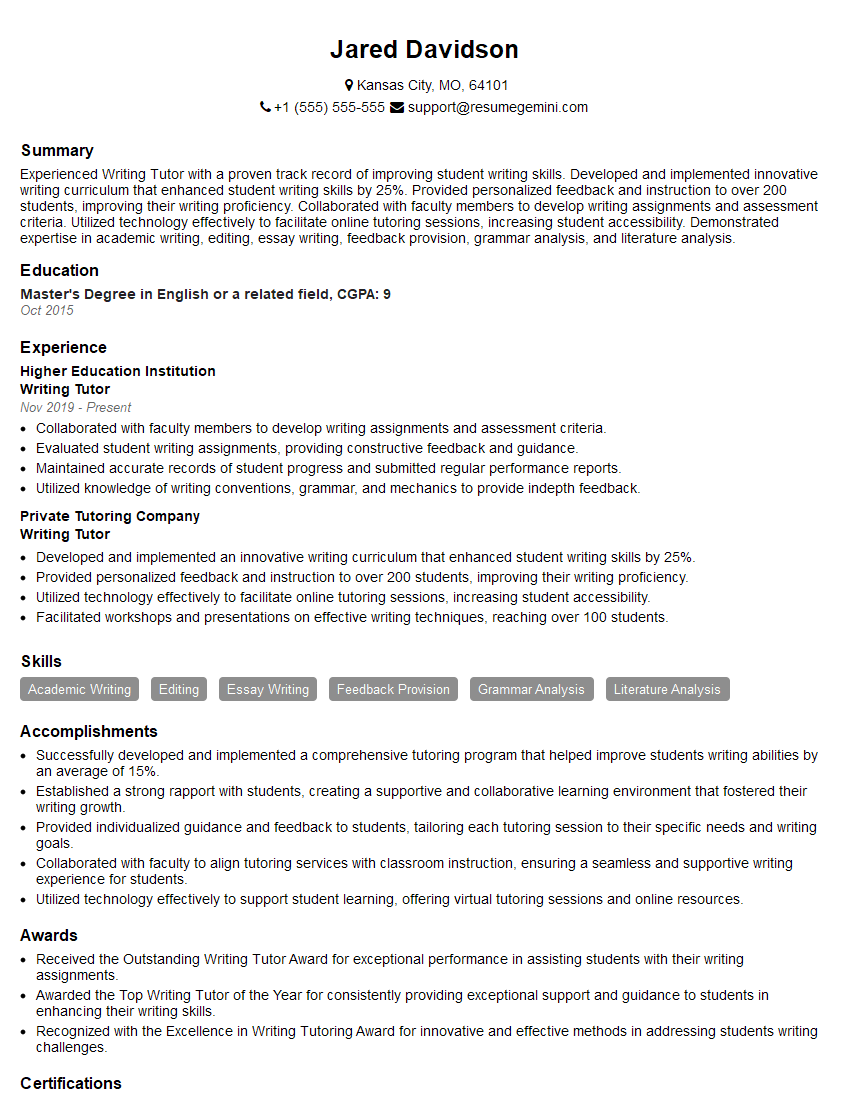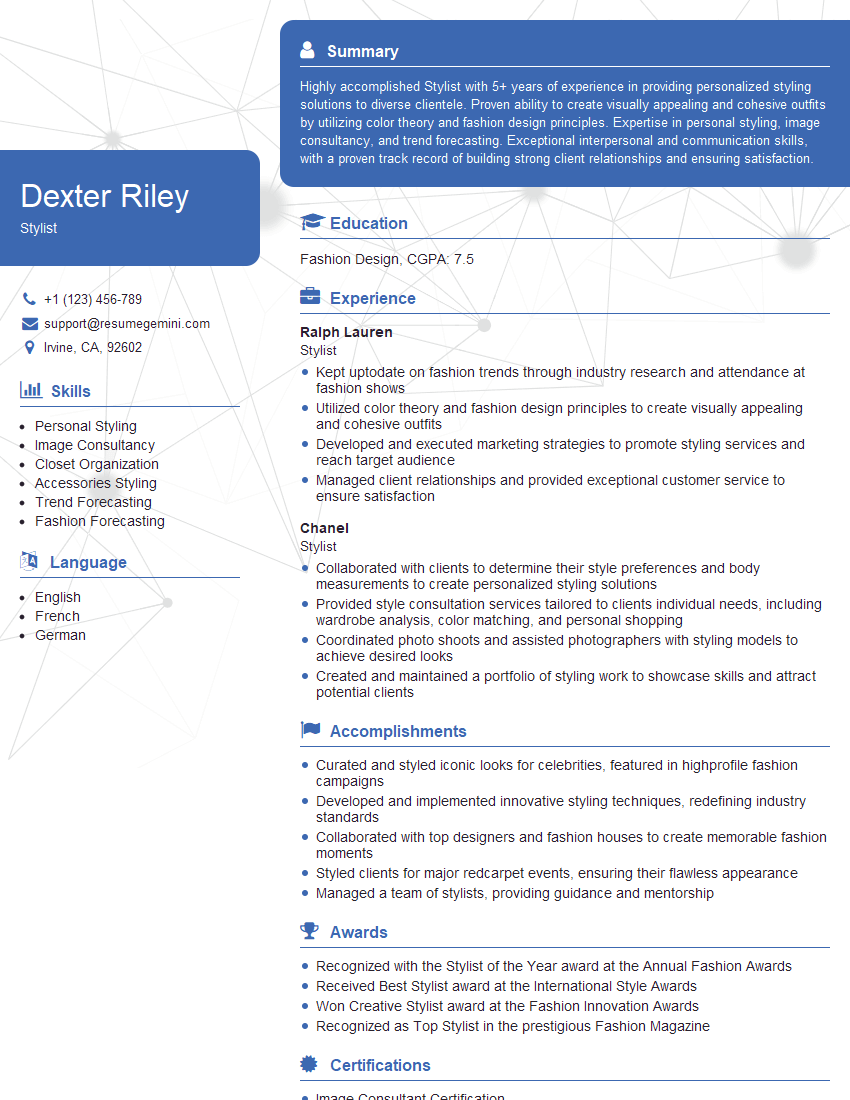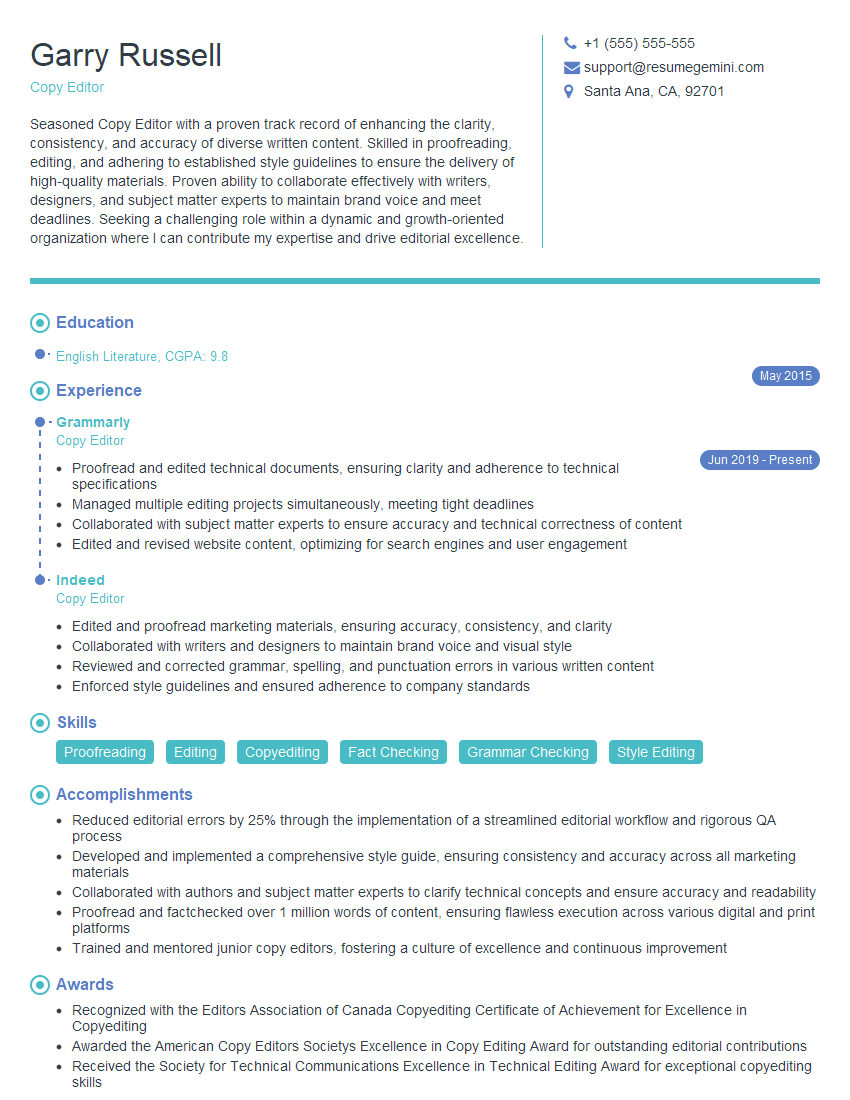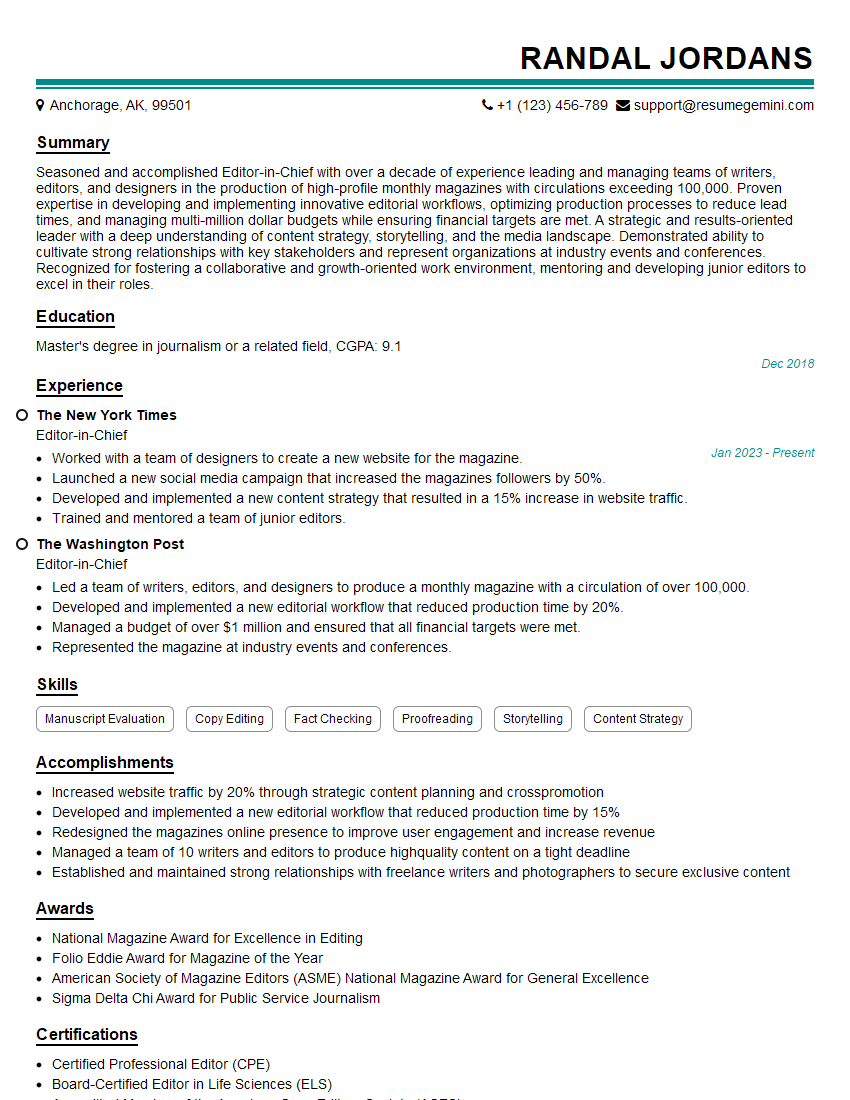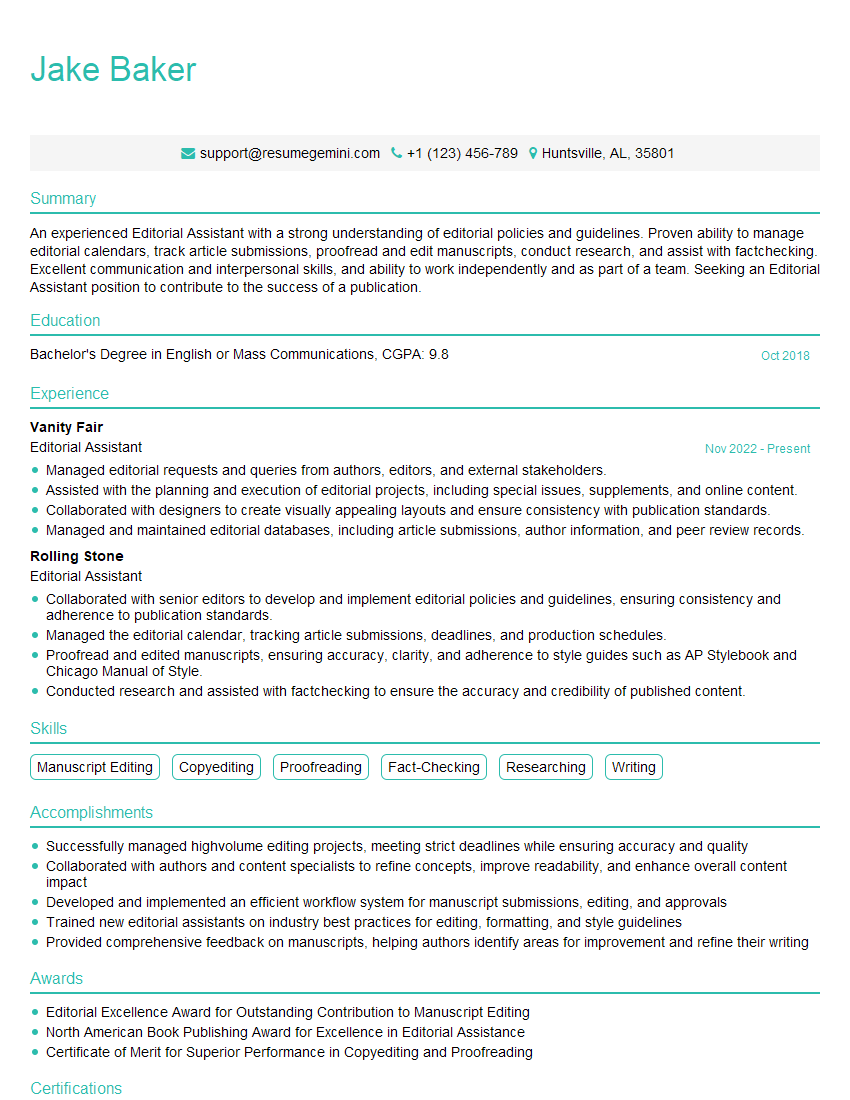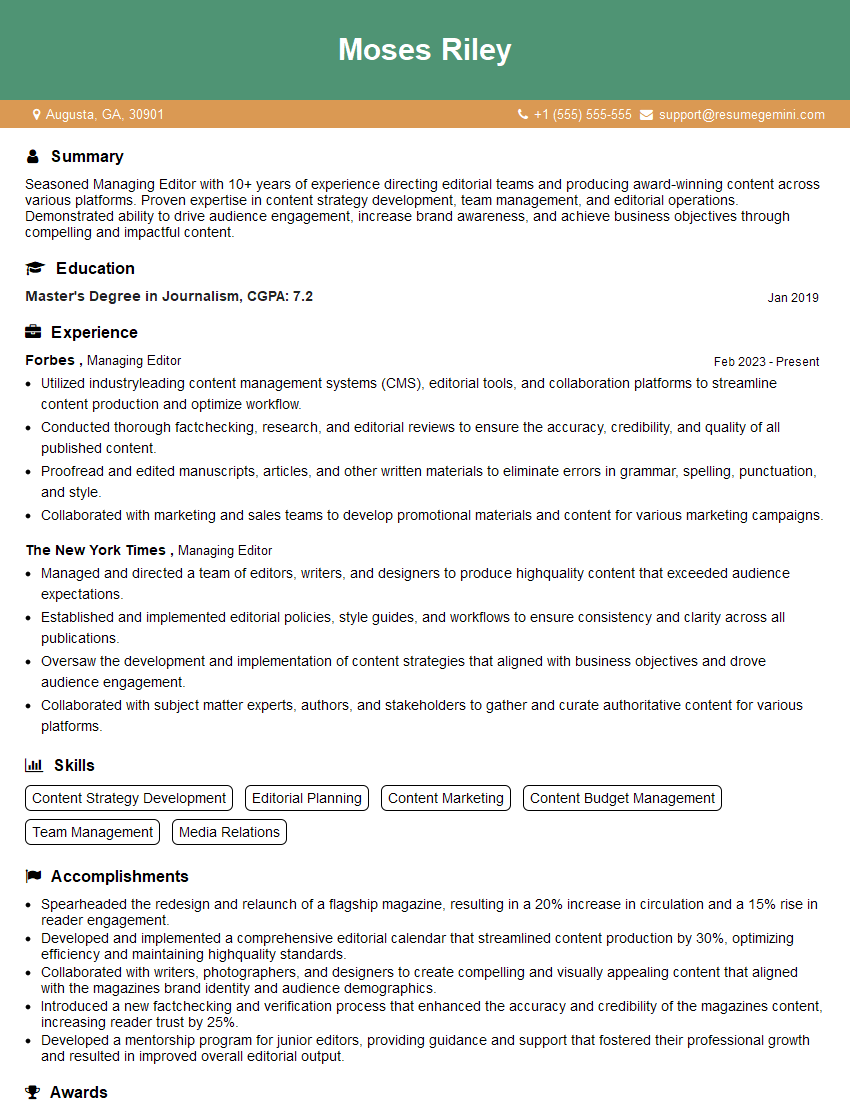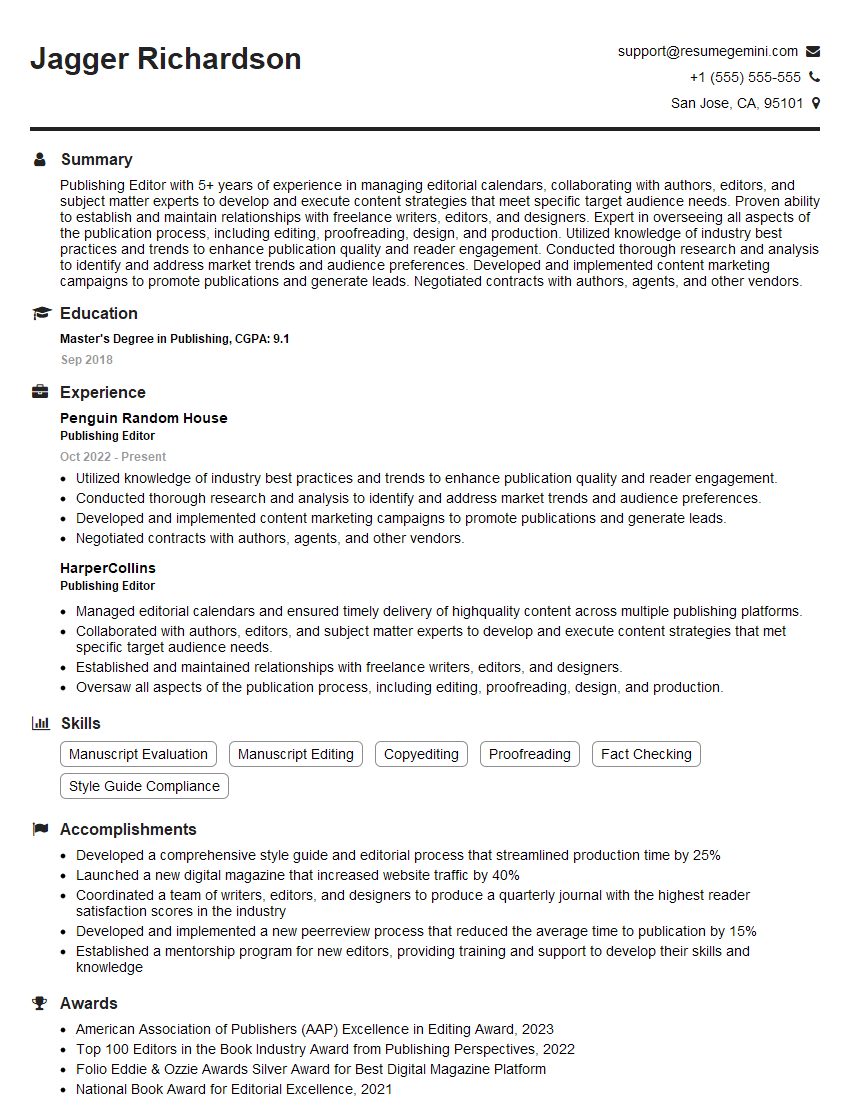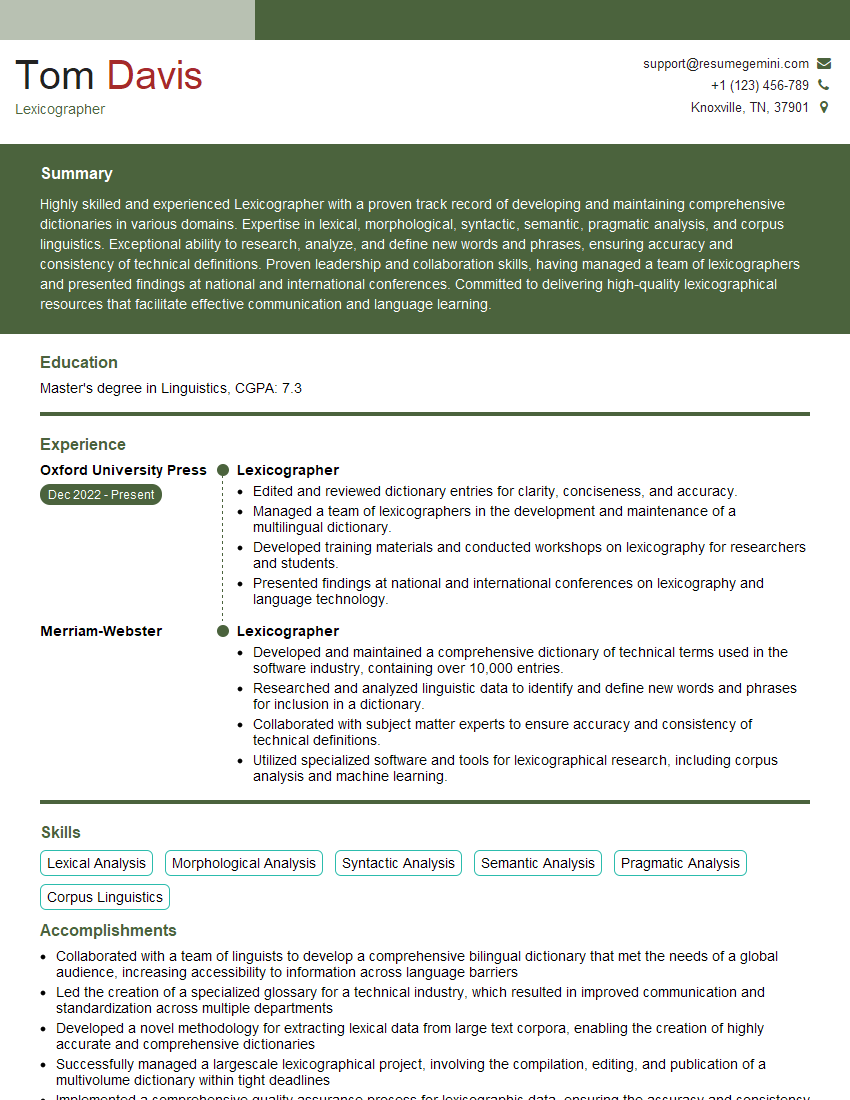Are you ready to stand out in your next interview? Understanding and preparing for Prescriptive Grammar interview questions is a game-changer. In this blog, we’ve compiled key questions and expert advice to help you showcase your skills with confidence and precision. Let’s get started on your journey to acing the interview.
Questions Asked in Prescriptive Grammar Interview
Q 1. Define prescriptive grammar and distinguish it from descriptive grammar.
Prescriptive grammar dictates how language should be used, focusing on rules and standards deemed correct by authorities. Think of it as the grammar police! It emphasizes correctness and adherence to established norms. Descriptive grammar, on the other hand, observes and analyzes how language is actually used without judgment. It’s more like a linguistic anthropologist, documenting language use in all its forms, including variations and dialects. The key difference lies in their objectives: prescription seeks to enforce rules, while description seeks to understand usage.
For example, prescriptive grammar might state that it’s incorrect to end a sentence with a preposition. Descriptive grammar would note that many native speakers routinely end sentences with prepositions and analyze the frequency and contexts of this usage.
Q 2. Explain the difference between a grammatical error and a stylistic choice.
A grammatical error violates established grammatical rules, leading to incorrect or unclear meaning. A stylistic choice, however, is a deliberate deviation from a rule for effect, often emphasizing a particular tone, style, or emphasis. The distinction often lies in intent and context.
For instance, using a sentence fragment like, “Running through the park,” is grammatically incorrect in formal writing because it lacks a main clause. But, as a stylistic choice in a narrative to convey speed and immediacy, it can be highly effective.
The use of colloquialisms, like “ain’t,” is typically a grammatical error in formal writing but acceptable in informal contexts. It becomes a stylistic choice based on audience and purpose.
Q 3. Discuss the role of prescriptive grammar in maintaining clarity and precision in writing.
Prescriptive grammar plays a crucial role in ensuring clarity and precision in writing. By adhering to established rules, writers avoid ambiguity and misinterpretations. Consistent application of rules like subject-verb agreement, parallel structure, and proper punctuation creates clear and logical sentences, facilitating easy comprehension for the reader.
Imagine reading a legal document, scientific report, or news article filled with grammatical errors. The lack of clarity would undermine the credibility of the information and potentially lead to significant misunderstandings. Prescriptive grammar provides the framework for precision in communication, making it essential in various professional settings.
Q 4. What are some common grammatical errors you frequently encounter?
Some common grammatical errors I frequently encounter include:
- Subject-verb disagreement (e.g., “The dogs chases the ball.”)
- Incorrect pronoun usage (e.g., “Between you and I”)
- Comma splices (e.g., “The cat sat on the mat, it was very comfortable.”)
- Misuse of apostrophes (e.g., “Its raining,” instead of “It’s raining.”)
- Faulty parallel structure (e.g., “She enjoys swimming, to run, and hiking.”)
- Dangling modifiers (e.g., “Walking down the street, the dog barked at me.”)
These errors, while seemingly minor, can significantly impact clarity and overall effectiveness of the writing.
Q 5. How do you approach correcting grammatical errors while preserving the author’s voice?
Correcting grammatical errors while preserving the author’s voice requires a delicate balance. My approach involves a two-step process:
- Understanding the Context: I first analyze the passage to understand the author’s style, tone, and intended message. Identifying the purpose and target audience is crucial.
- Subtle Correction: Instead of abruptly changing the sentence structure, I make subtle adjustments to correct the errors without altering the overall meaning or flow. This might involve rewording, adding or removing words, or adjusting punctuation.
For example, instead of completely rewriting a sentence with a comma splice, I might break it into two shorter, more grammatically correct sentences. Preserving the original phrasing helps maintain the author’s distinctive style and prevents the writing from sounding artificial or overly edited.
Q 6. Explain the importance of subject-verb agreement and provide examples.
Subject-verb agreement refers to the grammatical rule that requires the subject and verb of a sentence to agree in number (singular or plural). This means a singular subject takes a singular verb, and a plural subject takes a plural verb.
Examples:
The dog barks loudly.(Singular subject, singular verb)The dogs bark loudly.(Plural subject, plural verb)She is happy.(Singular subject, singular verb)They are happy.(Plural subject, plural verb)
Violating subject-verb agreement can lead to confusion and grammatical errors. Understanding this rule is fundamental to clear and correct writing.
Q 7. Define and illustrate the use of parallel structure in a sentence.
Parallel structure, also known as parallelism, is the grammatical technique of using the same grammatical structure for similar items in a list or series. It creates a sense of balance and rhythm, making sentences easier to understand and more aesthetically pleasing.
Examples:
- Incorrect: She likes swimming, to run, and hiking.
- Correct: She likes swimming, running, and hiking. (All are gerunds)
- Incorrect: He is intelligent, kind, and has a great sense of humor.
- Correct: He is intelligent, kind, and humorous. (All are adjectives)
Consistent parallel structure enhances clarity and readability, particularly in complex sentences or lists. It’s a vital tool for effective and professional writing.
Q 8. Identify and correct the errors in the following sentence: [Insert a sentence with grammatical errors]
Let’s assume the sentence with grammatical errors is: ‘Me and my friend went to the store, we bought some milk and then we went home.’
The errors lie in the pronoun case and the use of unnecessary conjunctions. The correct sentence is: ‘My friend and I went to the store, bought some milk, and then went home.’
Explanation: ‘Me’ is an objective pronoun; it should be used as the object of a verb or preposition. In this case, ‘I’ is the subject of the verb ‘went,’ hence the correct form. The repeated use of ‘we’ adds unnecessary wordiness, streamlining this makes the sentence more elegant and direct.
Q 9. Explain the rules governing pronoun case and agreement.
Pronoun case refers to the form a pronoun takes depending on its grammatical function in a sentence (subject, object, possessive). Pronoun agreement means a pronoun must agree in number (singular or plural) and gender (masculine, feminine, or neuter) with its antecedent (the noun or pronoun it refers to).
- Subjective Case: Used for subjects of verbs (I, you, he, she, it, we, they). Example:
She went to the park. - Objective Case: Used for objects of verbs or prepositions (me, you, him, her, it, us, them). Example:
The dog followed him. - Possessive Case: Shows ownership (my, mine, your, yours, his, her, hers, its, our, ours, their, theirs). Example:
That is her book.
Agreement: The pronoun must match its antecedent. Example: The team celebrated their victory. (plural antecedent ‘team’ requires plural pronoun ‘their’). Incorrect: The team celebrated his victory.
Ambiguity arises when antecedents are unclear. Consider carefully choosing pronouns to avoid confusion. For example, instead of: “John told Paul that he was wrong,” it’s clearer to say “John told Paul that Paul was wrong.” or “John told Paul that John was wrong.”
Q 10. How do you handle inconsistencies in style guides?
Inconsistencies in style guides are a common challenge. The best approach is to identify the core conflict and make a conscious, informed decision based on context and audience. A few strategies:
- Prioritize Audience and Purpose: Determine the most appropriate style for the intended audience and the purpose of the communication. A scientific report will have different stylistic needs than a marketing brochure.
- Consult a Senior Editor or Style Authority: In cases of significant uncertainty, seek guidance from an expert familiar with the specific guidelines and organizational preferences.
- Establish Internal Consistency: Once a decision is made, maintain consistency throughout the document. Use a style guide, even if it has minor inconsistencies, to ensure consistent usage within the document itself.
- Document Decisions: Maintain a record of all style decisions made to ensure consistency over multiple projects or documents.
Remember, consistency within a single document is paramount, even if the style is slightly different from another document or a specific style guide.
Q 11. Discuss the use of commas, semicolons, and colons in sentence structure.
Commas, semicolons, and colons are punctuation marks that structure and clarify sentences. They guide the reader through complex ideas.
- Commas (,) : Separate items in a list, join independent clauses with coordinating conjunctions (and, but, or, nor, for, so, yet), set off introductory elements, and clarify nonessential phrases or clauses. Example:
I bought apples, bananas, and oranges. - Semicolons (;) : Connect two closely related independent clauses without a conjunction. They are stronger than a comma and weaker than a period. Example:
The storm raged; the trees swayed violently. - Colons (:) : Introduce lists, explanations, or quotations. They signal a more formal pause than a comma or semicolon. Example:
I need three things: a pen, paper, and a quiet place.
Mastering the use of these punctuation marks ensures clarity and precision in your writing. Overuse or misuse can lead to ambiguity and grammatical errors. Always consider the relationship between the ideas being punctuated.
Q 12. Explain the differences between restrictive and non-restrictive clauses and their punctuation.
Restrictive and nonrestrictive clauses add information to sentences, but they differ in how essential that information is to the core meaning.
- Restrictive Clauses: Essential to the meaning of the sentence; they define or identify the noun they modify. They are not set off by commas. Example:
The book that I borrowed from the library is overdue.(The clause ‘that I borrowed from the library’ is essential to identify which book is overdue.) - Nonrestrictive Clauses: Add extra, non-essential information. They are set off by commas. Example:
My car, which is ten years old, still runs well.(The information about the car’s age is extra; the sentence would still make sense without it.)
The key distinction lies in whether removing the clause changes the core meaning of the sentence. If removing it significantly alters the meaning, it’s restrictive and requires no commas. If it doesn’t affect the core meaning, it’s nonrestrictive and needs commas.
Q 13. What are the different types of verb tenses and their appropriate usage?
Verb tenses indicate the time of an action or state of being. English has several tenses, each conveying a specific temporal nuance. Here’s a simplified overview:
- Simple Tenses: Simple Present (
I walk), Simple Past (I walked), Simple Future (I will walk) - Perfect Tenses: Express actions completed before a certain point in time. Present Perfect (
I have walked), Past Perfect (I had walked), Future Perfect (I will have walked) - Progressive (Continuous) Tenses: Emphasize the ongoing nature of an action. Present Progressive (
I am walking), Past Progressive (I was walking), Future Progressive (I will be walking) - Perfect Progressive Tenses: Combine perfect and progressive aspects, indicating ongoing action completed before a certain point. Present Perfect Progressive (
I have been walking), Past Perfect Progressive (I had been walking), Future Perfect Progressive (I will have been walking)
Proper tense usage depends heavily on context and the relationship between events in a narrative or description. Maintaining consistent and accurate tense usage is critical for clarity and effective communication.
Q 14. Explain the concept of dangling modifiers and provide examples.
A dangling modifier is a phrase or clause that doesn’t clearly modify any specific word or phrase in the sentence. It creates ambiguity and illogical meaning.
Example of a dangling modifier: Walking down the street, the dog barked at me.
This sentence implies the dog was walking down the street, which is incorrect. The modifier ‘Walking down the street’ is dangling; it lacks a clear grammatical connection.
Corrected sentence: As I was walking down the street, the dog barked at me. or While walking down the street, I heard a dog bark at me.
To avoid dangling modifiers, ensure the modifier clearly and logically modifies the intended word or phrase. Pay close attention to the placement of modifying phrases and clauses. Always check that the subject of the sentence is the one performing the action described in the modifying phrase.
Q 15. How do you identify and correct misplaced modifiers?
Misplaced modifiers occur when a descriptive phrase or clause is placed too far from the word it modifies, leading to ambiguity or unintended meaning. Think of it like trying to attach a label to the wrong item; it creates confusion.
Identifying Misplaced Modifiers: Read your sentences carefully, paying close attention to the placement of phrases beginning with participles (-ing words), adjectives, and prepositional phrases. Ask yourself: What word is this phrase describing? Does the placement make sense? If the phrase seems to modify the wrong word, you have a misplaced modifier.
Correcting Misplaced Modifiers: The solution is usually simple: move the modifier closer to the word it describes.
- Incorrect: Running down the street, the ice cream truck was spotted. (The ice cream truck isn’t running)
- Correct: I spotted the ice cream truck running down the street.
- Incorrect: Covered in chocolate, my dog looked happy. (Is the dog covered in chocolate or is the dog’s happiness what is covered in chocolate?)
- Correct: My chocolate-covered dog looked happy. or My dog, covered in chocolate, looked happy.
Another common error is the dangling modifier – where the word the phrase modifies is missing entirely.
- Incorrect: After working late, the report was finally finished. (The report didn’t work late!)
- Correct: After working late, I finally finished the report.
Career Expert Tips:
- Ace those interviews! Prepare effectively by reviewing the Top 50 Most Common Interview Questions on ResumeGemini.
- Navigate your job search with confidence! Explore a wide range of Career Tips on ResumeGemini. Learn about common challenges and recommendations to overcome them.
- Craft the perfect resume! Master the Art of Resume Writing with ResumeGemini’s guide. Showcase your unique qualifications and achievements effectively.
- Don’t miss out on holiday savings! Build your dream resume with ResumeGemini’s ATS optimized templates.
Q 16. Explain the rules regarding the use of apostrophes for possession and contractions.
Apostrophes serve two key grammatical functions: indicating possession and forming contractions.
Possession: We use apostrophes to show ownership or relationship. The placement depends on the noun.
- Singular nouns: Add ‘s. Example: the cat’s toy
- Plural nouns ending in -s: Add only an apostrophe. Example: the cats’ toys
- Plural nouns not ending in -s: Add ‘s. Example: the children’s playground
- Possessive pronouns: Pronouns like its, hers, his, ours, theirs, and yours do not use apostrophes.
Contractions: Apostrophes replace missing letters in contractions (shortened forms of words). Example: can’t (cannot), it’s (it is), they’re (they are), who’s (who is).
Common Mistakes:
- Using an apostrophe with possessive pronouns (e.g., your’s, her’s are incorrect).
- Incorrectly forming plural possessive (e.g., the cat’s toys instead of the cats’ toys for multiple cats).
- Overusing apostrophes to make words plural (e.g., apple’s instead of apples).
Q 17. Discuss the difference between active and passive voice and when to use each.
Active Voice: The subject performs the action. Example: The dog chased the ball. (The dog is the actor)
Passive Voice: The subject receives the action. Example: The ball was chased by the dog. (The ball is acted upon)
When to Use Each:
- Active Voice: Generally preferred for its clarity and directness. It makes writing more concise and engaging. Use it when you want to emphasize the actor and the action.
- Passive Voice: Appropriate when the actor is unknown, unimportant, or needs to be de-emphasized. It’s also useful when the focus should be on the action itself, or when you want to sound more formal or objective. For instance, scientific writing often uses passive voice.
Consider the following examples:
- The committee decided to postpone the meeting. (Active, clear and direct)
- The meeting was postponed by the committee. (Passive, less direct; ‘committee’ is still the focus, but less so)
- Mistakes were made. (Passive; the actor is unknown, but the focus is on the mistakes themselves)
Q 18. What are some common issues with verb tense consistency?
Inconsistent verb tense creates confusion and disrupts the flow of writing. It makes the narrative difficult to follow and can make the writing seem less credible.
Common Issues:
- Shifting between past and present tense unnecessarily: For example, starting a story in past tense and then suddenly switching to present tense mid-sentence or paragraph. This can be especially problematic when recounting a narrative.
- Mixing perfect tenses incorrectly: Using present perfect (have/has + past participle) when past simple is appropriate, or vice versa. This can lead to ambiguity about the timeframe of an action.
- Inconsistent use of future tense: Shifting between different ways of expressing the future (e.g., will, going to, present continuous) without a clear reason.
Solution: Carefully review your work, paying attention to the tense of your verbs. Choose a tense that suits the context and consistently stick to it unless there is a logical reason to shift tenses (e.g., indicating a flashback in a narrative).
Q 19. How do you determine the appropriate register and tone for a given writing task?
Register refers to the level of formality in your writing, while tone reflects the writer’s attitude toward the subject and audience. Choosing the appropriate register and tone is crucial for effective communication.
Determining Appropriate Register and Tone:
- Consider your audience: Are you writing for peers, superiors, clients, or the general public? A formal register is typically best for professional documents and academic writing, while informal register is appropriate for friendly letters or casual emails.
- Analyze the purpose: Are you trying to persuade, inform, entertain, or instruct? This affects both your tone and register. A persuasive piece might have a confident tone and formal register, while an informal email to a friend can be playful and informal in both tone and register.
- The context of the situation: For example, a report to a board of directors will require a much more formal register and a serious tone compared to a short internal memo.
Think of it like dressing for an occasion: you wouldn’t wear a tuxedo to a picnic, just as you shouldn’t use overly formal language when emailing a close friend. Choosing the right register and tone ensures your message is well-received and understood.
Q 20. Explain the importance of using precise vocabulary in writing.
Precise vocabulary is essential for clear and effective communication. Using the right words ensures your message is accurately conveyed and leaves no room for misinterpretation. Vague language leads to confusion.
Importance of Precise Vocabulary:
- Clarity: Precise words leave no ambiguity. For instance, instead of saying ‘a large dog,’ you could use ‘a Great Dane’ for greater specificity.
- Credibility: Using precise vocabulary demonstrates a strong understanding of your subject matter and enhances your credibility as a writer.
- Engagement: Precise and vivid language makes writing more interesting and engaging for the reader.
Example: Instead of saying ‘He was sad,’ consider alternatives that express the specific nuance of his sadness: ‘He was heartbroken,’ ‘He was despondent,’ or ‘He was melancholic.’
Q 21. What are some strategies for improving sentence clarity and conciseness?
Clarity and conciseness are hallmarks of good writing. They ensure your message is easily understood and avoids unnecessary wordiness.
Strategies for Improvement:
- Eliminate unnecessary words and phrases: Words like ‘very,’ ‘really,’ and ‘quite’ often add little to the meaning. Cut them out when possible.
- Use strong verbs: Avoid weak verbs like ‘is’ or ‘was’ when stronger, more active verbs can be used.
- Combine sentences: Short, choppy sentences can be merged for better flow. However, avoid excessively long sentences which can be difficult to follow.
- Replace wordy phrases with single words: For example, ‘at this point in time’ can be shortened to ‘now,’ and ‘due to the fact that’ to ‘because’.
- Read your work aloud: Listening to your writing can help identify awkward phrasing and sentences that need revision.
Example: The sentence ‘In the event that it rains, the picnic will be postponed’ can be revised to the concise and clear: ‘If it rains, the picnic will be postponed.’
Q 22. Discuss the challenges of editing text written in dialects or non-standard English.
Editing dialectal or non-standard English presents unique challenges because it requires a nuanced understanding of linguistic variation while maintaining clarity and consistency. It’s not about imposing a single ‘correct’ form, but rather about making informed decisions based on the context and purpose of the text.
The primary challenge is balancing the preservation of the author’s voice and style with the need for clear communication. For instance, if the text aims for authenticity, using standardized English might erase the unique cultural identity reflected in the dialect. However, if the goal is broad accessibility, some level of standardization might be necessary.
- Understanding regional variations: A word or phrase perfectly acceptable in one region might be incomprehensible elsewhere. For example, ‘y’all’ in the Southern US is perfectly clear to Southerners but might confuse a reader from another region.
- Navigating grammatical differences: Dialects often deviate from standard grammar rules. For example, the use of double negatives (‘I ain’t got none’) is grammatically incorrect in standard English but common in many dialects. The editor must decide whether to maintain this feature or adjust it for wider readability.
- Avoiding bias and cultural insensitivity: Editors must be mindful of the potential for perpetuating stereotypes or undermining cultural identities when making editorial choices regarding dialect. The goal is to make appropriate adjustments, not to erase the author’s unique background.
Ultimately, the approach must be sensitive, informed, and context-dependent, involving careful consideration of the intended audience and the purpose of the text.
Q 23. How do you approach editing text with multiple grammatical errors and inconsistencies?
Editing text riddled with grammatical errors and inconsistencies requires a systematic and prioritized approach. Think of it like tackling a complex puzzle; you can’t fix everything at once.
- Identify the most egregious errors first: Start with errors that significantly impede understanding, like subject-verb agreement problems, misplaced modifiers, or faulty sentence structure. Correcting these foundational issues will greatly improve overall clarity.
- Prioritize consistency: Once the major errors are addressed, focus on ensuring consistency in style, tense, and voice. For example, if the author switches between past and present tense unnecessarily, correct these inconsistencies for a smoother read.
- Address punctuation and mechanics: Next, turn your attention to punctuation and mechanics, such as comma splices, missing commas, incorrect apostrophe use, and capitalization errors. This stage enhances readability and precision.
- Review word choice and style: In the final phase, consider refining word choice, eliminating jargon or clichés, and ensuring a consistent style aligns with the text’s purpose and audience. This ensures the writing is polished and impactful.
Throughout the process, I use a combination of automated grammar and spell checkers, but I always rely on my own judgment and knowledge of grammar. I prefer to work in stages, saving and backing up my work frequently. A step-by-step approach allows for a more efficient editing process and prevents overwhelming myself.
Q 24. Explain your experience using style guides such as the Chicago Manual of Style or AP Stylebook.
I have extensive experience using both the Chicago Manual of Style (CMOS) and the Associated Press Stylebook (AP). My choice depends heavily on the type of document I’m editing.
CMOS, with its detailed approach to grammar, punctuation, and bibliographic formatting, is indispensable for academic writing, books, and other formal publications. I rely on CMOS for its comprehensive guidance on matters like capitalization, punctuation usage, and citation formats. For example, CMOS provides specific guidance on the use of serial commas, a detail often overlooked but crucial for accurate and clear writing.
Conversely, AP style, known for its brevity and conciseness, is essential for journalism and other forms of fast-paced writing. Its emphasis on clarity and accuracy makes it particularly useful when dealing with factual information. For instance, AP style dictates specific capitalization rules for titles and specific guidelines for numerals and abbreviations.
I seamlessly adapt my approach based on the publication’s style requirements. Familiarity with both style guides allows me to efficiently adapt to diverse projects, ensuring consistency and accuracy in my edits regardless of the preferred style.
Q 25. Describe your process for proofreading a complex document.
Proofreading a complex document demands a methodical and multi-stage approach to ensure accuracy.
- First Read: I focus on the overall flow, argumentation, and clarity of the text. This isn’t a detailed edit; I’m looking for major structural flaws or inconsistencies.
- Second Read (Detailed): I go sentence by sentence, scrutinizing grammar, punctuation, spelling, and style. I use a ruler or my finger to guide my eye, preventing me from skipping lines.
- Third Read (Focus): I perform a targeted review, focusing specifically on aspects relevant to the type of document. For example, in a scientific paper, I’d concentrate on the accuracy of data representation and the consistency of terminology. In a legal document, the precision of language and the adherence to legal conventions would be my priority.
- Final Check: I often take a break before a final read to review the document with fresh eyes. This helps catch errors I may have missed during previous readings.
Using different tools, like a text-to-speech program or reading aloud myself, can also be surprisingly effective at catching overlooked errors. I always print out a hard copy for at least one read, as this helps identify issues that might be missed when viewing a document onscreen.
Q 26. How do you prioritize different types of grammatical errors when editing?
Prioritizing grammatical errors is crucial for efficiency and clarity. I typically follow a hierarchy based on the impact on the text’s understandability and overall quality:
- Errors affecting meaning: These include subject-verb agreement, pronoun reference, and sentence fragments. These are prioritized because they directly impact a reader’s ability to grasp the message.
- Errors affecting clarity: Misplaced modifiers, comma splices, and run-on sentences compromise readability and flow. These need to be addressed for a smoother reading experience.
- Errors affecting style and consistency: Inconsistencies in tense, voice, or punctuation may not directly affect meaning, but they create a jarring effect and weaken the overall quality of the writing.
- Minor errors: Spelling and typographical errors are the lowest priority, as they rarely affect the overall meaning but can still impact professionalism.
It’s essential to balance speed and accuracy. Fixing every minor error upfront can slow down the editing process unnecessarily. My approach centers around first ensuring the text is fundamentally clear and accurate, then enhancing its style and polish.
Q 27. What are your strategies for working collaboratively with other editors or writers?
Collaborative editing requires clear communication, mutual respect, and a shared understanding of the project’s goals. I find success lies in establishing open channels for feedback and a willingness to compromise.
- Clear Communication: I use version control systems to track changes and facilitate discussion. This allows others to see suggested edits, and offer comments or counter-suggestions.
- Shared Style Guide: Before starting any collaborative project, I ensure everyone is working from the same style guide to minimize inconsistencies.
- Constructive Feedback: I give feedback that is specific, actionable, and framed constructively, focusing on improving the text without being overly critical.
- Respect for Diverse Perspectives: I recognize that different editors have different strengths and viewpoints. I actively seek input from others, acknowledging that their perspectives can lead to improvements I might miss.
Effective collaboration hinges on clear communication, mutual respect, and a shared vision. By embracing these principles, I ensure that the final product is superior to what any single editor could have achieved alone.
Q 28. How do you stay updated on changes in grammar rules and style conventions?
Staying current in grammar and style requires continuous learning and engagement with the field.
- Professional Journals and Publications: I regularly read publications such as American Editor and other journals focused on writing and editing to stay abreast of the latest trends and discussions.
- Style Guide Updates: I closely follow updates to style guides like CMOS and AP, ensuring I have the latest versions. Many style guides now offer online updates and resources.
- Online Resources and Courses: I utilize online resources and occasionally enroll in short courses to refresh my knowledge and learn about new tools and techniques.
- Networking with Other Editors: Attending conferences and workshops, and participating in online communities, provides valuable opportunities for knowledge sharing and professional development.
The ever-evolving nature of language and style necessitates ongoing learning. Consistent engagement ensures that I remain a proficient and up-to-date editor in a constantly changing linguistic landscape.
Key Topics to Learn for Prescriptive Grammar Interview
- Parts of Speech and Their Functions: Master the nuances of nouns, pronouns, verbs, adjectives, adverbs, prepositions, conjunctions, and interjections. Understand their various forms and how they function within a sentence.
- Sentence Structure and Types: Gain a deep understanding of sentence diagramming, identifying subjects, predicates, phrases, and clauses. Practice analyzing different sentence types (simple, compound, complex, compound-complex) and their effective use.
- Agreement: Sharpen your skills in subject-verb agreement, pronoun-antecedent agreement, and parallel structure. Understand how to identify and correct errors in agreement.
- Tense and Aspect: Demonstrate a thorough knowledge of verb tenses and aspects, including perfect, progressive, and perfect progressive forms. Practice choosing the appropriate tense to convey accurate meaning.
- Punctuation and Mechanics: Master the correct usage of punctuation marks (commas, semicolons, colons, apostrophes, quotation marks, etc.) and other mechanics (capitalization, hyphenation, etc.) to ensure clear and grammatically sound writing.
- Common Grammatical Errors: Familiarize yourself with frequently encountered grammatical errors, such as dangling modifiers, misplaced modifiers, and faulty parallelism. Learn how to effectively identify and rectify these issues.
- Style and Tone: Understand how to adapt your writing style and tone to suit different contexts and audiences. Practice writing in a clear, concise, and grammatically correct manner.
- Practical Application: Practice editing and proofreading texts for grammatical accuracy. Focus on applying your knowledge to real-world scenarios, such as writing professional emails, reports, and documents.
Next Steps
Mastering prescriptive grammar is crucial for career advancement, enhancing your communication skills, and improving your overall professionalism. A strong understanding of grammar is essential for clear and effective written communication in any professional setting. To maximize your job prospects, create an ATS-friendly resume that highlights your grammatical expertise. ResumeGemini is a trusted resource to help you build a professional resume that showcases your skills effectively. Examples of resumes tailored to highlight Prescriptive Grammar skills are available to help you get started.
Explore more articles
Users Rating of Our Blogs
Share Your Experience
We value your feedback! Please rate our content and share your thoughts (optional).
What Readers Say About Our Blog
Live Rent Free!
https://bit.ly/LiveRentFREE
Interesting Article, I liked the depth of knowledge you’ve shared.
Helpful, thanks for sharing.
Hi, I represent a social media marketing agency and liked your blog
Hi, I represent an SEO company that specialises in getting you AI citations and higher rankings on Google. I’d like to offer you a 100% free SEO audit for your website. Would you be interested?



